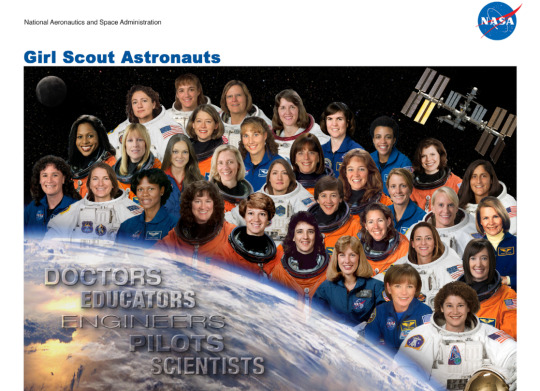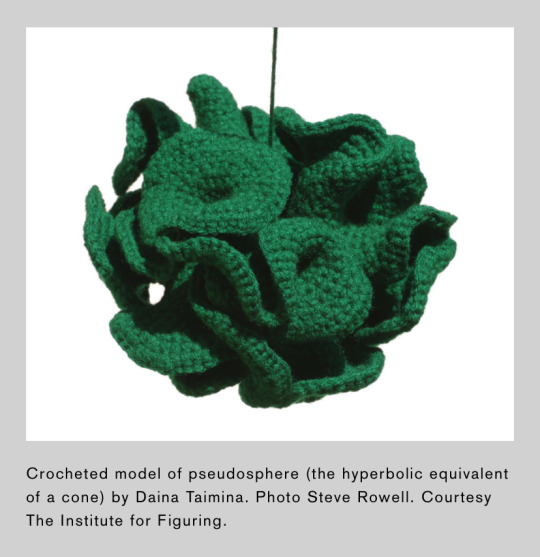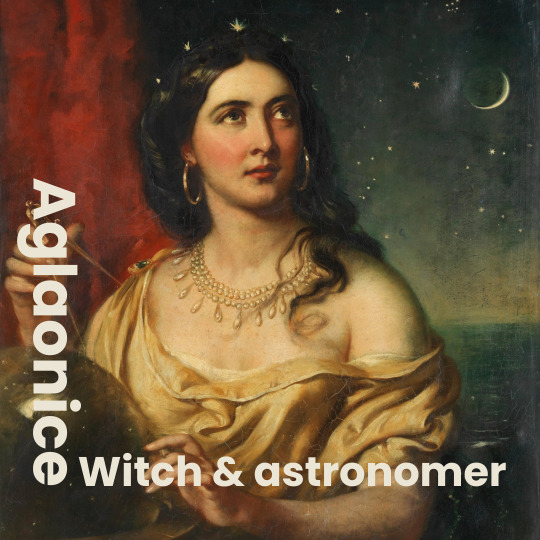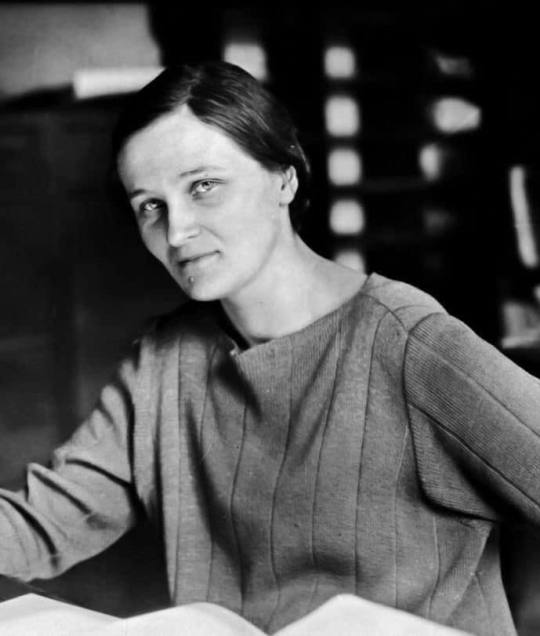#women in science
Text

It’s Girl Scout Day! March 12, 2024, is the 112th birthday of Girl Scouts in the United States, and to celebrate, we’re sharing a lithograph of the Girl Scout alumnae who became NASA astronauts.
Girl Scouts learn to work together, build community, embrace adventurousness and curiosity, and develop leadership skills—all of which come in handy as an astronaut. For example, former Scouts Christina Koch and Jessica Meir worked together to make history on Oct. 18, 2019, when they performed the first all-woman spacewalk.
Pam Melroy is one of only two women to command a space shuttle and became NASA’s deputy administrator on June 21, 2021.
Nicole Mann was the first Indigenous woman from NASA to go to space when she launched to the International Space Station on Oct. 5, 2022. Currently, Loral O’Hara is aboard the space station, conducting science experiments and research.
Participating in thoughtful activities in leadership and STEM in Girl Scouts has empowered and inspired generations of girls to explore space, and we can’t wait to meet the future generations who will venture to the Moon and beyond.
Make sure to follow us on Tumblr for your regular dose of space!
#NASA#space#space exploration#Girl Scouts#adventure#explore#inspiration#inspirational women#Womens History Month#WHM#science#STEM#women in STEM#women in science#International Space Station#ISS#astronaut#tech#technology
2K notes
·
View notes
Text
41K notes
·
View notes
Text

Hello all! I took a break from the Internet but I am back! Little update: I am now in year two of my degree, and I started organic chemistry! Very excited for this year's journey:) 🧪
#chemistry#college#science#stem academia#study aesthetic#studyblr#studyspo#biology#study blog#women in stem#education#rambles#tumblrpost#thank you#women in science#light academia#study notes#school#another day another slay#laboratory#study blr#study motivation
423 notes
·
View notes
Text



#bindi irwin#feminism#feminist#ecology#endometriosis#endo safe#women's health#chronic fatigue#disability#disabilities#chronic conditions#health#medicine#women's rights#women in science#women in stem#reproductive rights
1K notes
·
View notes
Text
It took about two hours for Daina Taimina to find the solution that had eluded mathematicians for over a century. It was 1997, and the Latvian mathematician was participating in a geometry workshop at Cornell University. David Henderson, the professor leading the workshop, was modelling a hyperbolic plane constructed out of thin, circular strips of paper taped together. 'It was disgusting,' laughed Taimina in an interview.
A hyperbolic plane is 'the geometric opposite' of a sphere, explains Henderson in an interview with arts and culture magazine Cabinet. 'On a sphere, the surface curves in on itself and is closed. A hyperbolic plane is a surface in which the space curves away from itself at every point.' It exists in nature in ruffled lettuce leaves, in coral leaf, in sea slugs, in cancer cells. Hyperbolic geometry is used by statisticians when they work with multidimensional data, by Pixar animators when they want to simulate realistic cloth, by auto-industry engineers to design aerodynamic cars, by acoustic engineers to design concert halls. It's the foundation of the theory of relativity, and thus the closest thing we have to an understanding of the shape of the universe. In short, hyperbolic space is a pretty big deal.
But for thousands of years, hyperbolic space didn't exist. At least it didn't according to mathematicians, who believed that there were only two types of space: Euclidean, or flat space, like a table, and spherical space, like a ball. In the nineteenth century, hyperbolic space was discovered - but only in principle. And although mathematicians tried for over a century to find a way to successfully represent this space physically, no one managed it - until Taimina attended that workshop at Cornell. Because as well as being a professor of mathematics, Taimina also liked to crochet.
Taimina learnt to crochet as a schoolgirl. Growing up in Latvia, part of the former Soviet Union, 'you fix your own car, you fix your own faucet - anything', she explains. 'When I was growing up, knitting or any other handiwork meant you could make a dress or a sweater different from everybody else's.' But while she had always seen patterns and algorithms in knitting and crochet, Taimina had never connected this traditional, domestic, feminine skill with her professional work in maths. Until that workshop in 1997. When she saw the battered paper approximation Henderson was using to explain hyperbolic space, she realised: I can make this out of crochet.
And so that's what she did. She spent her summer 'crocheting a classroom set of hyperbolic forms' by the swimming pool. 'People walked by, and they asked me, "What are you doing?" And I answered, "Oh, I'm crocheting the hyperbolic plane."' She has now created hundreds of models and explains that in the process of making them 'you get a very concrete sense of the space expanding exponentially. The first rows take no time but the later rows can take literally hours, they have so many stitches. You get a visceral sense of what "hyperbolic" really means.' Just looking at her models did the same for others: in an interview with the New York Times Taimina recalled a professor who had taught hyperbolic space for years seeing one and saying, 'Oh, so that's how they look.' Now her creations are the standard model for explaining hyperbolic space.

-Caroline Criado Perez, Invisible Women
Photo credit
#caroline criado perez#Daina Taimina#women in stem#women’s history#women in science#crochet#crocheting#female mathematicians#hyperbolic space
183 notes
·
View notes
Text
fact: there is so much of the natural world we don't understand yet
many forms of women's spirituality is just... celebrating how cool that is. not believing in any fictional narrative. just celebrating nature and how much we have yet to understand.
that's why I take issue with the "it's just as fictional as Christianity etc" narrative. some forms, sure, but not any I'd ever be interested in.
it's just ignorance. your idea of witchcraft vs what I'm actually talking about. but you aren't taking the time to ask or listen. there's literally nothing "unscientific" about what I personally practice. it's just about my relationship to the scientific unknown.
edit to add some of what I just included in a different reblog:
fwiw, I still don't consider myself spiritual as (like I've repeatedly said) my witchcraft is, to me, artistic self-expression and is fundamentally about my personal connection to the universe, womanhood, nature, and, despite what certain women on here are insisting, to science. I've never been able to convince myself to believe in specific unseen/supernatural things like deities (learned this at a very young age trying to make myself believe in the Christian God, then tried with other gods, never believed in Santa even).
women engaging in scientific pursuits have historically so often been the ones labeled witches. new scientific creations have so often historically been called magic, witchcraft, heresy, etc., and those involved persecuted for it.
historically, women called witches have so often BEEN scientists, and that & the erasure of women throughout scientific history is exactly WHY using the term is so important to me, WHY I don't respect the patriarchally-derived dictionary definition* of "witch" or "witchcraft." I have a peer-reviewed neuroscience publication with my name on it, and that, to me, is part of my witchcraft. idc how anyone else feels about that but calling it antifeminist is absurd.
#i get that some people will never be able to understand that#but can you please just let us be about it?#the fact i never even said anything about “magic” but yall keep projecting about it anyway...#like its ok to not understand it!#bc it's fundamentally about you as an individual/your internal relationship to the world#my saying some of you will never understand that is NOT a dig at those ppl#it's just a neutral statement of fact#mine#witchcraft discourse#witchcraft#brujeria#women in science
143 notes
·
View notes
Text

During the second or first century BCE, a woman pretended to be able to control the moon. This was Aglaonice, who is regarded by some as the first known female astronomer.
She’s mentioned in the writings of Plutarch and the scholia to Apollonius of Rhodes and lived in Thessaly, Greece. Being “skilled in astronomy”, Aglaonice used her knowledge to predict eclipses and make people believe she caused the moon to disappear.
According to Plutarch:
“Thoroughly acquainted with the periods of the full moon and when it is subject to eclipse, and, knowing beforehand the time when the moon was due to be overtaken by the earth’s shadow, imposed upon the women, and made all believe she was drawing the moon down.”
The scholia adds that Aglaonice lost a close relation as a punishment for having angered the moon goddess.
Interestingly, Thessaly is associated with women skilled in astronomy and occult practices. Several female astrologers from the third to first centuries BCE were for instance known as “The Witches of Thessaly”. These women were said to study the movements of the moon and trick people into believing that they caused lunar eclipses.
In Plato's Gorgias, Socrates mentions the "Thessalian enchantresses who, as they say, bring down the moon from heaven at the risk of their own destruction."
Today, a crater on Venus bears Aglaonice’s name.
Feel free to check out my Ko-Fi if you like what I do! Your support would be greatly appreciated.
Further reading:
Bicknell Peter, "The witch Aglaonice and dark lunar eclipses in the second and first centuries BC."
Chrystal Paul, Women in Ancient Greece
Plutarch, On the failure of oracles
Plutarch, Conjugalia Praecepta
Reser Anna, McNeil Leila, Forces of Nature: the women who changed science
#aglaonice#history#women in history#women's history#women in science#herstory#greece#ancient greece#antiquity#scientists#astronomy#historyedits#1st century BCE#ancient world#historical figures
86 notes
·
View notes
Text



molecular neurobiology mandatory-elective or pre-thesis work? the best answer is both!!🧫🪭
#saját#studyblr#lizystudying#myown#lizysinpain#studying#study#study vibes#lizysvibe#lizybionics#neuroscience#science#women in stem#women in science#neurobiology#neuro#lizyslabvibes#lab#laboratory#pre thesis#thesis work#studyspo
91 notes
·
View notes
Text
It's International Day of Women and Girls in Science!

#STEM#women#science#women in science#drawing#digital art#draw#illustration#drawn#satrun twins#satrun
513 notes
·
View notes
Text

I did not know that!
“Since her death in 1979, the woman who discovered what the universe is made of has not so much as received a memorial plaque. Her newspaper obituaries do not mention her greatest discovery. […] Every high school student knows that Isaac Newton discovered gravity, that Charles Darwin discovered evolution, and that Albert Einstein discovered the relativity of time. But when it comes to the composition of our universe, the textbooks simply say that the most abundant atom in the universe is hydrogen. And no one ever wonders how we know.”
—
Jeremy Knowles, discussing the complete lack of recognition Cecilia Payne gets, even today, for her revolutionary discovery. (via alliterate)
OH WAIT LET ME TELL YOU ABOUT CECILIA PAYNE.
Cecilia Payne’s mother refused to spend money on her college education, so she won a scholarship to Cambridge.
Cecilia Payne completed her studies, but Cambridge wouldn’t give her a degree because she was a woman, so she said to heck with that and moved to the United States to work at Harvard.
Cecilia Payne was the first person ever to earn a Ph.D. in astronomy from Radcliffe College, with what Otto Strauve called “the most brilliant Ph.D. thesis ever written in astronomy.”
Not only did Cecilia Payne discover what the universe is made of, she also discovered what the sun is made of (Henry Norris Russell, a fellow astronomer, is usually given credit for discovering that the sun’s composition is different from the Earth’s, but he came to his conclusions four years later than Payne—after telling her not to publish).
Cecilia Payne is the reason we know basically anything about variable stars (stars whose brightness as seen from earth fluctuates). Literally every other study on variable stars is based on her work.
Cecilia Payne was the first woman to be promoted to full professor from within Harvard, and is often credited with breaking the glass ceiling for women in the Harvard science department and in astronomy, as well as inspiring entire generations of women to take up science.
Cecilia Payne is awesome and everyone should know her.
352 notes
·
View notes
Text

Sun Cactus
Disocactus speciosus. SciArt by Louise-Cécile Descamps-Sabouret for Revue Horticole (1899).
View more in Biodiversity Heritage Library with thanks to Harvard University Botany Libraries for digitizing.
#bhlib#histsciart#sciart#flowers#natural history#women in Science#women in Art#Sun Cactus#cactus#flowercore#flower aesthetic#HerNaturalHistory
116 notes
·
View notes
Text
The doors to science for too long were shut to women—and the struggle continues—yet women still have managed to contribute invaluable work. Here are 5 open collections on JSTOR that feature the work of important women botanists and botanical artists.
#women in science#women's art#women scientists#botany#brilliant botany#plants#botanical art#botanist#research#jstor
370 notes
·
View notes
Photo

Nichelle Nichols was born on December 28, 1932. An American actress, singer, and dancer best known for her portrayal of Nyota Uhura in Star Trek and its film sequels. Nichols’ portrayal of Uhura was groundbreaking for African American actresses on American television. From 1977 until 2015, Nichols volunteered her time to promote NASA’s programs and recruit diverse astronauts, including some of the first female and ethnic minority astronauts. When she considered leaving Star Trek, Martin Luther King, Jr. asked her to stay, citing her influence on black women and children who could see themselves reflected on television as equals. Former NASA astronaut Mae Jemison has cited Nichols’ role of Lieutenant Uhura as her inspiration for wanting to become an astronaut .
#nichelle nichols#star trek#star trek the original series#uhura#nyota uhura#nasa#women in science#women in history#science#science birthdays#science history#on this day#on this day in science history#rip#rest in peace
468 notes
·
View notes
Text

#studio ghibli#nausicaä of the valley of the wind#anime#gif#screencaps#movie gifs#film gifs#80s anime#80s movies#80s film#science#scientists#explore#adventurecore#women in stem#women in science#lol these tags I need to stop#ghibli#ghibli films#goblincore#fantasy#scifi#sci fi movies#science fantasy#science fiction#nature
488 notes
·
View notes
Text
So apparently today is also #WorldStickInsectDay? ¯\_(ツ)_/¯

Marianne North (British, 1830-90)
Leaf-Insects and Stick-Insects, Java, c.1876
oil on board, H 35.5 x W 24.4 cm
Kew Gardens Marianne North Gallery MN676
#animals in art#animal holiday#european art#19th century art#Marianne North#natural history art#painting#oil painting#women artists#women in science#British art#insect#insects#Phasmatodea#Kew Gardens#World Stick Insect Day
102 notes
·
View notes
Text
On This Day In History
March 5th, 1938: American biologist Lynn Margulis was born. Her widespread contributions rewrote our understanding of early life and her ideas were so radical they were rejected and ignore for a decade before she was vindicated.
It’s thanks to Dr. Margulis that we understand why the mitochondria is the powerhouse of the cell!
240 notes
·
View notes